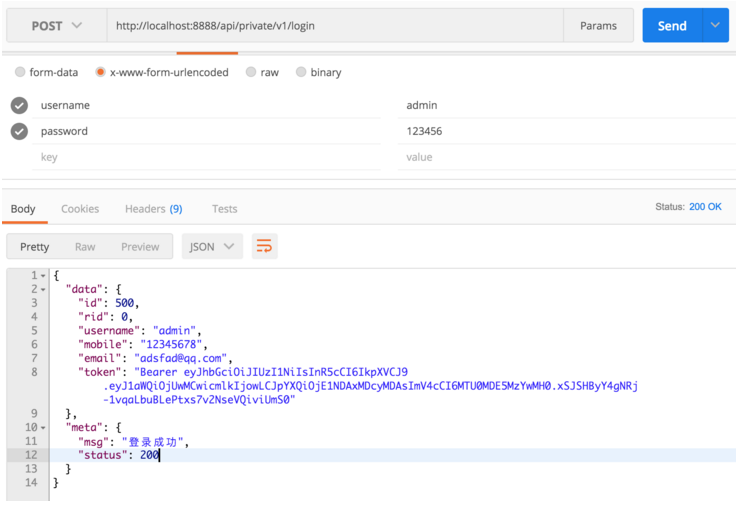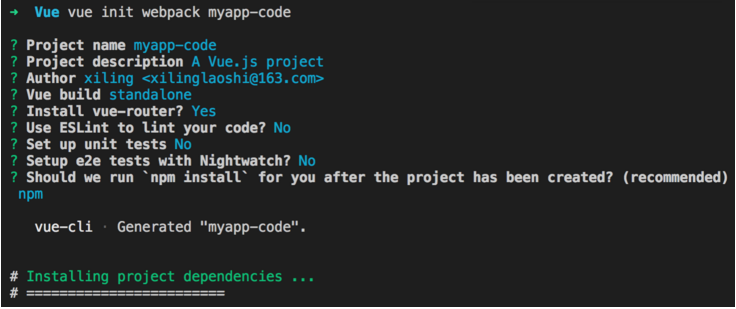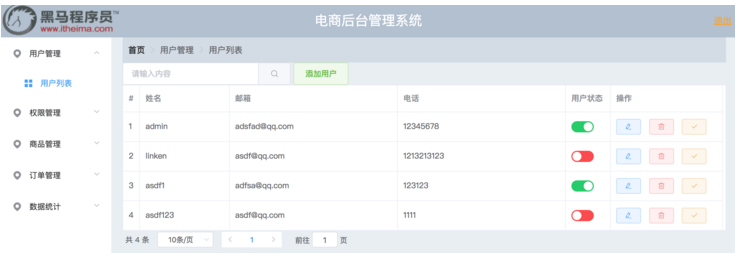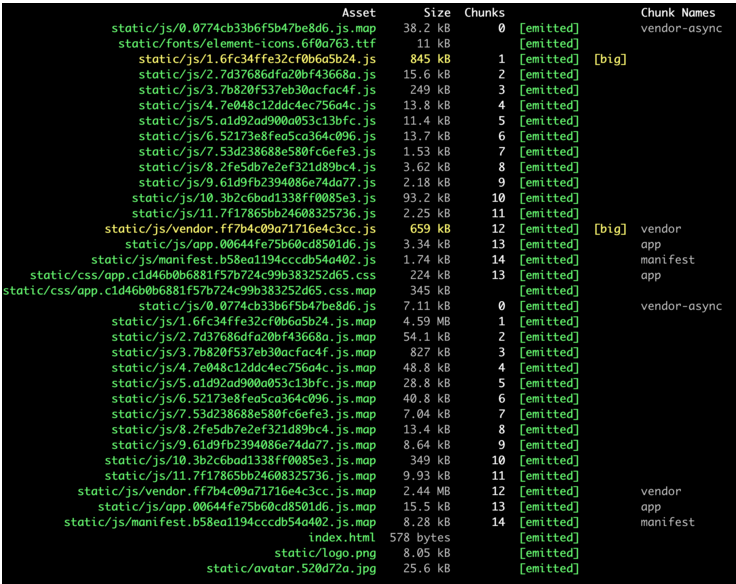第0章 项目如何开始的
0.1 总体流程
需求调研-->需求转为需求文档-->将需求文档转为开发文档-->前端文档-->后台文档-->项目测试-->打包上线
0.2 数据服务器构建
0.2.1 技术栈
Vue+elementUI+NodeJS+MySQL
0.2.2 数据服务器准备
导入数据库数据:打开数据库服务器,新建名为 itcast 的库;
后台为我们提供了 /api-server/db/mydb.sql 数据文件,打开复制 sql 语句直接运行即可;
然后在 api-server 中执行 npm install 安装服务器所需扩展模块;
node app.js 将服务器启动起来;
0.3 接口测试
0.3.1 登录
后台已经写好接口文档,根据文档中的表述,我们测试登录接口:

0.3.2 获取用户信息
请求用户列表数据;但是,并没有返回相应的数据;



0.4 Vue项目初始化
使用 vue-cli 工具初始化项目:

初始化成功,使用 npm run dev 启动项目;
0.5 项目预览
解压 my-project(Vue项目).rar 后进入目录,使用 npm run dev 启动项目;

第1章 开始项目
1.1 添加用户登录路由组件
添加路由:myapp-code/src/router/index.js
import Vue from 'vue'
import Router from 'vue-router'
import Login from '@/components/login/login'
Vue.use(Router)
export default new Router({
routes: [
{
path:'/login',
name:'Login',
component:Login
}
]
})添加组件:`myapp-code/src/components/login/login.vue`
<template>
<div>{{msg}}</div>
</template>
<script>
export default{
data(){
return {msg:'我是登录页面'}
}
}
</script>
<style>
</style>修改Vue 项目运行端口: myapp-code/config/index.js
1.2 使用 ElementUI
http://element-cn.eleme.io/#/zh-CN

修改 src/main.js 代码,全局引入 ElementUI ;
import Vue from 'vue'
import App from './App'
import router from './router'
// 引入 ElementUI
import ElementUI from 'element-ui'
import 'element-ui/lib/theme-chalk/index.css';
// 将 ElementUI 注册为 vue的全局组件
Vue.use(ElementUI);
Vue.config.productionTip = false
new Vue({
el: '#app',
router,
components: { App },
template: '<App/>'
})在我们登录页面中尝试一下:` src/components/login/login.vue`
<template>
<div>
<el-button type="success">成功按钮</el-button>
<el-button type="info">信息按钮</el-button>
<el-button type="warning">警告按钮</el-button>
<el-button type="danger">危险按钮</el-button>
</div>
</template>1.3 搭建登录页面
把公共样式写到 src/assets/css/style.css : Form 表单
html,
body {
height: 100%;
}
body {
margin: 0;
padding: 0;
}然后在 src/main.js 加载公共样式:
// 代码略...
// 引入我们的公共样式
import './assets/css/style.css'
// 代码略...为了让登陆组件的背景色撑满,所以我们需要让他们的父盒子 div#app 高度设置为 100%。
所以我们在 src/App.vue :
<style>
#app {
height: 100%;
}
</style>接下来我们开始调整 src/components/login/login.vue 组件样式:
-
注意:这里遵循一个原则,不要直接去使用 Element 组件自带的类名
-
如果你想为 Element 组件添加自定义样式,那么建议你给它加你自己的类名来控制
<template>
<div class="login-wrap">
<el-form ref="form" :label-position="labelPosition" :model="form" label-width="80px" class="login-from" >
<h2>用户登录</h2>
<el-form-item label="用户名">
<el-input v-model="form.name"></el-input>
</el-form-item>
<el-form-item label-position="top" label="密码">
<el-input v-model="form.pwd" ></el-input>
</el-form-item>
<el-form-item>
<el-button type="primary" @click="onSubmit" class="login-btn" >登录</el-button>
</el-form-item>
</el-form>
</div>
</template>
<script>
export default {
data() {
return {
labelPosition:'top',
form: {
name: "",
pwd: ""
}
};
},
methods:{
onSubmit(){}
}
};
</script><style>
.login-wrap {
background-color: #324152;
height: 100%;
display: flex;
justify-content: center;
align-items: center;
}
.login-wrap .login-from {
background-color: #fff;
width: 400px;
padding: 30px;
border-radius: 5px;
}
.login-wrap .login-from .login-btn {
width: 100%;
}
</style>1.4 完成登录功能
1.4.1 封装axios
vue 插件语法: https://cn.vuejs.org/v2/guide/plugins.html
Axios : https://www.kancloud.cn/yunye/axios/234845
npm install axios ,将 axios 进行模块化封装,以 Vue 插件的方式,全局引入:
将插件的封装写入 src/assets/js/myaxios.js
// 引入axios
import Axios from 'axios';
// 自定义插件对象
var myaxios = {};
myaxios.install = function(vue){
// 设置axios请求的URL,此后axios发送的请求全部执行本地址
var axios_obj = Axios.create({
baseURL:'http://localhost:8888/api/private/v1/'
})
// 将设置好的axios对象赋值给Vue实例的原型
// 之后可以在Vue中直接只用 this.$myHttp 使用axios发送请求
vue.prototype.$myHttp = axios_obj;
}
// 将插件以 模块 方式导出
export default myaxios;在 main.js 引入axios插件,并注册为全局插件
// 导入 myaxios 模块
import myaxios from '@/assets/js/myaxios.js'
Vue.use(myaxios) // 注册使用 axios 插件1.4.2 完成登录功能
发送post请求
export default {
data() {
return {
labelPosition:'top',
form: {
username: "",
password: ""
}
};
},
methods:{
// 修改组件中绑定的按钮名称为 onLogin
onLogin(){
// 使用axios 发送post 请求,传入data中的form数据
this.$myHttp.post('login',this.form)
.then(backdata=>{ // 异步执行成功后
console.log(backdata);
});
}
}
};继续修改代码,完成登录逻辑:
vue-router编程式导航: https://router.vuejs.org/zh/guide/essentials/navigation.html
onLogin(){
// 使用axios 发送post 请求,传入data中的form数据
this.$myHttp.post('login',this.form)
.then(backdata=>{ // 异步执行成功后
//console.log(backdata.data);
// 结构赋值,获取返回的数据
var {data,meta} = backdata.data;
// 判断数据状态
if(meta.status == 200){
alert('登录成功');
// 使用vue-router编程式导航跳转到home
this.$router.push('home');
}
});
}修改提示弹窗
var { data, meta } = backdata.data;
// 判断数据状态
if (meta.status == 200) {
this.$message({
message: "恭喜你,登录成功",
type: "success"
});
// 使用vue-router编程式导航跳转到home
this.$router.push("home");
}else{
this.$message.error('错了哦');
}1.4.3 表单验证
Form 组件提供了表单验证的功能,只需要通过 rules 属性传入约定的验证规则,并将 Form-Item 的 prop 属性设置为需校验的字段名即可。
data() {
return {
labelPosition: "top",
form: {
username: "",
password: ""
},
// 与 el-form 中的 :rules="rules" 对应
rules: {
//与 el-form-item 中的 prop="username" 对应
username: [
// 验证规则 是否必须 提示信息 触发时机
{ required: true, message: "请输入用户名", trigger: "blur" }
],
password: [
{ required: true, message: "请输入密码", trigger: "blur" },
{ min: 3, max: 5, message: "长度在 3 到 5 个字符", trigger: "blur" }
]
}
};
},
1.4.4 阻止数据提交
onLogin() {
// 因为要获取form表单的节点对象,
// 所以 el-form 中要加入 ref="ruleForm"
this.$refs.ruleForm.validate(valid => {
// elementUI 会将 validate 方法加入到节点对象,
// 在提交是,如果表单的验证未通过,会将错误信息传入回调函数
if (!valid) {
// 如果有表单错误信息,则无反应
this.$message.error("输入有误");
return;
}
// 使用axios 发送post 请求,传入data中的form数据
this.$myHttp.post("login", this.form).then(backdata => {
// 结构赋值,获取返回的数据
var { data, meta } = backdata.data;
// 判断数据状态
if (meta.status == 200) {
this.$message({
message: "恭喜你,登录成功",
type: "success"
});
// 使用vue-router编程式导航跳转到home
this.$router.push("home");
} else {
this.$message.error("错了哦");
}
});
});
}1.5 首页
1.5.1 添加路由及页面布局
修改登录成功后逻辑,使用路由名称表示进行跳转:
// 使用vue-router编程式导航跳转到home
this.$router.push({name:"home"});导入组件,添加路由 `src/router/index.js`
import Home from '@/components/home/home'
……
{
path:'/',
name:'home',
component:Home
}添加一个home组件`src/components/home/home.vue`
<template>
<div>{{msg}}</div>
</template>
<script>
export default {
data(){
return{
msg:'we'
}
}
}
</script>修改一个home组件src/components/home/home.vue ` Container 布局容器`
<template>
<el-container class="height100">
<el-header>Header</el-header>
<el-container>
<el-aside width="200px">Aside</el-aside>
<el-main>Main</el-main>
</el-container>
</el-container>
</template>
.height100{
height: 100%;
}
.el-header {
background-color: #B3C0D1;
color: #333;
text-align: center;
line-height: 60px;
}
.el-aside {
background-color: #D3DCE6;
color: #333;
text-align: center;
line-height: 200px;
}
.el-main {
background-color: #E9EEF3;
color: #333;
text-align: center;
line-height: 160px;
}1.5.2 头部样式
/src/components/home/home.vue
Layout 布局
<el-header>
<el-row>
<el-col :span="6">
<div class="grid-content bg-purple">
<img src="/static/logo.png" alt="">
</div>
</el-col>
<el-col :span="12"><div class="grid-content bg-purple-light">电商后台管理系统</div></el-col>
<el-col :span="6"><div class="grid-content bg-purple"><el-button type="warning">退出</el-button></div></el-col>
</el-row>
</el-header>
……
// 标题文本样式
.bg-purple-light {
font-size: 25px;
color: white;
}1.5.3 左侧样式
/src/components/home/home.vue
NavMenu 导航菜单 Icon 图标
<el-container>
<el-aside width="200px">
<!--
el-menu 侧边导航栏组件
unique-opened="true" 只保持一个导航开启
router="true" 开启导航路由
el-submenu 导航栏的顶级项
template 导航栏中需要展示的内容
i 图标
span 文字
el-menu-item-group 次级导航组 内容与导航的组标识 可直接删除
el-menu-item 导航栏选项
index属性 控制收起展开+路由标识:
在el-menu中加入router=“true”属性;
index="1-1" 点击时路由跳转到1-1 ;
-->
<el-menu
:unique-opened="true"
:router="true"
default-active="2"
class="el-menu-vertical-demo"
@open="handleOpen"
@close="handleClose">
<el-submenu index="1" >
<template slot="title">
<i class="el-icon-location"></i>
<span>用户管理</span>
</template>
<el-menu-item index="1-1">
<i class="el-icon-menu"></i>
用户列表
</el-menu-item>
</el-submenu>
<el-submenu index="2" >
<template slot="title">
<i class="el-icon-location"></i>
<span>权限管理</span>
</template>
<el-menu-item index="2-1">
<i class="el-icon-menu"></i>
角色列表
</el-menu-item>
<el-menu-item index="2-2">
<i class="el-icon-menu"></i>
权限列表
</el-menu-item>
</el-submenu>
</el-menu>
</el-aside>
<el-main>Main</el-main>
</el-container>我们发现,大部分组件,在浏览器渲染后,都会在标签内部自动添加一个标签名为名字的 class 属性 ,我们可以利用这个属性,设置样式:
.el-menu{
width: 200px;
height: 100%
}
.el-submenu{
text-align: left;
}1.5.4 右侧内容
添加组件内容 /src/components/home/home.vue
<el-main>
<!-- 路由组件 -->
<router-view></router-view>
</el-main>添加组件:`src/components/index.vue`
<template>
<p>我是首页内容</p>
</template>
<script>
export default {
}
</script>
<style>
</style>添加路由:`/src/router/index.js`
{
path:'/index',
name:'index',
component:Index
}注意: 我们希望index.vue 组件的内容,展示到home组件的 <router-view></router-view>中
知识补充:
此时,我们需要借助嵌套路由: https://router.vuejs.org/zh/guide/essentials/nested-routes.html
嵌套路由(子路由的基本用法):
<script src="./vue.js"></script>
<script src="./vue-router.js"></script>
<div id="app">
<router-view></router-view>
</div>
<script>
// 1:定义路由组件
var login = {
template: `
<div>
<h2>我是登录页面</h2>
<li><router-link to="/zi">子路由</router-link></li>
<!--路由组件中继续使用路由组件-->
<router-view></router-view>
</div>
`
}
var zi = {
template: '<h4>我是嵌套路由的组件</h4>'
}
// 2:获取路由对象
var router = new VueRouter({
// 定义路由规则
routes: [
{
name: 'login',
path: "/login",
component: login,
// 路由中的 children 属性,定义嵌套路由(子路由)
children: [
{ name: 'zi', path: "/zi", component: zi }
]
},
]
})
var app = new Vue({
el: '#app',
router
})
</script>*再谈 代码加载流程 *
(main.js->template: '<App/>')替换 (index.html->div#app);
(index.html-><App/>) --> (components: { App })
( components: { App }) --> (import App from './App' -> src/App.vue)
(App.vue -> <router-view/> -> 路由组件) --> (main.js-> router)
========此项决定了页面展示那个组件内容 ========
({path: '/',name: 'HelloWorld', component: HelloWorld }) --> (import HelloWorld from '@/components/HelloWorld')
(src/components/HelloWorld.vue) --> <router-view/>因此,我们需要让 index 成为 home 的子路由组件 `src/router/index.js`
routes: [
{
path:'/login',
name:'Login',
component:Login
},
{
path:'/',
name:'home',
component:Home,
// 添加子路由
children:[
{path:'index',name:'index',component:Index}
]
},
]登录完成后,跳转到 home-->index `src/components/login/login.vue`
if (meta.status == 200) {
this.$message({
message: "恭喜你,登录成功",
type: "success"
});
// 使用vue-router编程式导航跳转到home->index
this.$router.push({name:"index"});
}1.6 验证首页登录
src/components/login/login.vue
if (meta.status == 200) {
this.$message({
message: "恭喜你,登录成功",
type: "success"
});
// 登录成功后,将token信息保存到 localStorage
window.localStorage.setItem('token',data.token);
// 使用vue-router编程式导航跳转到home->index
this.$router.push({name:"index"});
}在 src/components/home/home.vue 验证登录
export default {
// 使用生命周期的钩子函数,判断token
mounted() {
// 获取token
var token = window.localStorage.getItem("token");
if (!token) {
// 错误提示
this.$message.error("请登录");
// 跳转到登录页面
this.$router.push({ name: "Login" });
}
},
data() {
return {
msg: "we"
};
}
};1.7 用户退出
绑定点击事件
<el-col :span="6">
<div class="grid-content bg-purple">
<el-button @click="loginOut" type="warning">退出</el-button>
</div>
</el-col>
methods:{
loginOut(){
// 清楚token
window.localStorage.removeItem('token')
// 退出提示
this.$message({
message: "您已经退出,继续操作请重新登录",
type: "success"
});
// 页面路由跳转
this.$router.push({ name: "Login" });
}
}第2章 用户管理
2.1 路由及组件
/src/components/home/home.vue
<el-menu-item index="users">
<i class="el-icon-menu"></i>
用户列表
</el-menu-item>src/router/index.js
import Users from '@/components/users/users'
……
children:[
{path:'index',name:'index',component:Index},
{path:'users',name:'users',component:Users}
]src/components/users/users.vue
<template>
<div>展示用户列表表格</div>
</template>
<script>
export default {
}
</script>
<style>
</style>2.2 面包屑导航及搜索框
src/components/users/users.vue Card 卡片 Breadcrumb 面包屑 Input 输入框 Button 按钮
<template>
<div>
<!-- 面包鞋 -->
<el-card>
<el-breadcrumb separator-class="el-icon-arrow-right">
<el-breadcrumb-item :to="{ path: '/index' }">首页</el-breadcrumb-item>
<el-breadcrumb-item>用户管理</el-breadcrumb-item>
<el-breadcrumb-item>用户列表</el-breadcrumb-item>
</el-breadcrumb>
</el-card>
</div>
</template>……
</el-card>
<el-row>
<el-col :span="6" class="sou">
<el-input placeholder="请输入内容" v-model="input5" class="input-with-select">
<el-button slot="append" icon="el-icon-search"></el-button>
</el-input>
</el-col>
<el-col :span="1" class="sou">
<el-button type="success" plain>添加用户</el-button>
</el-col>
</el-row>
</div>
……
<script>
export default {
data(){
// 不想看到报错
return{input5:''}
}
};
</script>
<style>
.sou{
line-height:30px
}
</style>2.3 展示用户列表
2.3.4 组件展示
src/components/users/users.vue Table 表格->自定义索引
<!-- 表格 自定义索引 -->
<el-table
:data="tableData"
style="width: 100% ;">
<el-table-column
type="index"
:index="indexMethod">
</el-table-column>
<el-table-column
prop="date"
label="日期"
width="180">
</el-table-column>
<el-table-column
prop="name"
label="姓名"
width="180">
</el-table-column>
</el-table>
</div>
</template>
<script>
export default {
data() {
return {
input5:'',
tableData: [
{
date: "2016-05-03",
name: "王小虎"
}
]
};
}
};
</script>
<style>
.sou {
line-height: 30px;
}
.el-main{
line-height:30px;
}
</style>2.3.5 获取数据
出登录接口,其他接口发送http请求,必须携带token值
Axios : https://www.kancloud.cn/yunye/axios/234845 ---> 请求配置
data() {
return {
input5:'',// 不想看到报错
// 设置页码及条数
pagenum:1,
pagesize:5,
tableData: []
};
},
// 利用钩子函数,获取数据
mounted() {
// 获取token
let token = window.localStorage.getItem('token');
// 通过配置选项发送请求
// 携带token
this.$myHttp({
// 设置链接地址 es6新语法
url:`users?pagenum=${this.pagenum}&pagesize=${this.pagesize}`,
method:'get',
// 配置token
headers: {'Authorization': token}
}).then(res=>{
// 修改数据 展示页面
this.tableData = res.data.data.users;
})
},修改组件参数,展示数据:
<el-table-column prop="username" label="姓名" > </el-table-column>
2.3.6 操作按钮
Button 按钮 Table 表格->自定义列模板
<el-table-column label="操作" width="210">
<template slot-scope="scope">
<el-button type="primary" icon="el-icon-edit" size="mini" plain></el-button>
<el-button type="primary" icon="el-icon-check" size="mini" plain></el-button>
<el-button type="primary" icon="el-icon-delete" size="mini" plain></el-button>
</template>
</el-table-column>表格中加入按钮等元素时,需要使用 template 进行包裹:
<el-table-column label="用户状态" width="210">
<template slot-scope="scope">
<el-switch
v-model="value2"
active-color="#13ce66"
inactive-color="#ff4949">
</el-switch>
</template>
</el-table-column>2.3.7 状态显示
而在template 标签中有一个 slot-scope="scope" 属性,scope 的值就是本列中所有数据的值,参考: Table 表格->固定列
<el-table-column label="用户状态" width="210">
<template slot-scope="scope">
<!-- 利用scope 中的值,争取显示用户状态 -->
<el-switch v-model="scope.row.mg_state" active-color="#13ce66" inactive-color="#ff4949"></el-switch>
<!-- 测试事件,查看 scope 数据 -->
<el-button type="primary" size="mini" @click="showScope(scope)">显示scope</el-button>
</template>
</el-table-column>methods:{
// 测试 方法 显示scope
showScope(scope){
console.log(scope);
}
},2.3.8 分页展示
Pagination 分页->附加功能
<!-- 分页 -->
<!--
current-page 当前页码数
page-sizes 显示条数选项
page-size 当前每页条数
-->
<el-pagination
@size-change="handleSizeChange"
@current-change="handleCurrentChange"
:current-page="pagenum"
:page-sizes="[2, 20, 40]"
:page-size="pagesize"
layout="total, sizes, prev, pager, next, jumper"
:total="total">
</el-pagination>
</div>
</template>
……
<script>
……
data() {
return {
input5:'',// 不想看到报错
pagenum:1, //设置页码
pagesize:2, // 设置页条数
total:0, //显示总条数
tableData: []
};
},
……
……
// 获取总条数 修改数据展示
this.total = res.data.data.total;但点击页码时,会触发 size-change 事件
<script>
export default {
data() {
return {
input5: "", // 不想看到报错
pagenum: 1, //设置页码
pagesize: 2, // 设置页条数
total: 0, //显示总条数
tableData: []
};
},
methods: {
// 获取用户数据
getUserData() {
// 获取token
let token = window.localStorage.getItem("token");
// 通过配置选项发送请求
// 携带token
this.$myHttp({
// 设置链接地址 es6新语法
url: `users?pagenum=${this.pagenum}&pagesize=${this.pagesize}`,
method: "get",
// 配置token
headers: { Authorization: token }
}).then(res => {
// 修改数据 展示页面
this.tableData = res.data.data.users;
// 获取总条数 修改数据展示
this.total = res.data.data.total;
});
},
// 点击页码触发
handleCurrentChange(pages) {
// console.log(pages);
// 修改data数据,重新发送请求
this.pagenum = pages;
this.getUserData();
},
// 改变显示条数时触发
handleSizeChange(numbers){
this.pagesize = numbers;
this.getUserData();
}
},
// 利用钩子函数,获取数据
mounted() {
this.getUserData();
}
};
</script>2.4 模糊搜索
请求地址中加入 query 请求参数,获取条件结果
<el-input placeholder="请输入内容" v-model="search" class="input-with-select">
<el-button slot="append"
@click="searchUsers"
icon="el-icon-search"></el-button>
</el-input>
……
<script>
data() {
return {
search: "", // 搜索关键字
};
},
// 请求地址中加入关键字
url: `users?pagenum=${this.pagenum}&pagesize=${this.pagesize}&query=${this.search}`,
// 点击搜索事件
searchUsers(){
this.getUserData();
}
</script>2.5 切换用户状态
<!-- 利用scope 中的值,争取显示用户状态 -->
<!-- 组件自带change事件 -->
<el-switch v-model="scope.row.mg_state" @change="change(scope)" active-color="#13ce66" inactive-color="#ff4949"></el-switch>// Switch 开关 组件自带事件
change(scope){
// 接受本条全部信息
// console.log(scope)
let id = scope.row.id; // 获取id
var state = scope.row.mg_state; // 获取修改后的状态
// 请求接口
this.$myHttp.put(`users/${id}/state/${state}`)
.then(res=>{
// 修改失败,将状态改为原始值
if(!res.data.data){
this.tableData[scope.$index].mg_state = !state;
this.$message.error("修改失败");
}
})
}修改失败是因为没有token:
// Switch 开关 组件自带事件
change(scope){
// 接受本条全部信息
// console.log(scope)
let id = scope.row.id; // 获取id
var state = scope.row.mg_state; // 获取修改后的状态
// 请求接口
// 需要使用配置参数请求,设置token
this.$myHttp({
url:`users/${id}/state/${state}`,
method:'put',
headers: { Authorization: window.localStorage.getItem("token") }
})
.then(res=>{
// 修改失败,将状态改为原始值
if(!res.data.data){
this.tableData[scope.$index].mg_state = !state;
this.$message.error("修改失败");
}
})
}2.6 删除用户
MessageBox 弹框->确认消息
// 组件中绑定点击按钮
<el-button type="primary" icon="el-icon-delete" size="mini" @click="deleteUser(scope.row.id)" plain></el-button>
// 删除用户
deleteUser(id) {
// this.$myHttp({
// url: `users/${id}`,
// method: "delete",
// headers: { Authorization: window.localStorage.getItem("token") }
// }).then(res => {
// this.getUserData();
// this.$message({
// message: "删除成功",
// type: "success"
// });
// });
this.$confirm("此操作将永久删除该用户, 是否继续?", "提示", {
confirmButtonText: "确定",
cancelButtonText: "取消",
type: "warning"
})
.then(() => {
this.$myHttp({
url: `users/${id}`,
method: "delete",
headers: { Authorization: window.localStorage.getItem("token") }
}).then(res => {
this.getUserData();
this.$message({
message: "删除成功",
type: "success"
});
});
})
.catch(() => {
this.$message({
type: "info",
message: "已取消删除"
});
});
}2.7 添加用户
Dialog对话框->自定义内容->打开嵌套表单的 Dialog Form 表单
表单弹窗:
<el-col :span="1" class="sou">
<!-- 绑定按钮点击事件 直接将 dialogFormVisible值设置为true显示窗口 -->
<el-button type="success" @click="dialogFormVisible = true" >添加用户</el-button>
<!--
:visible.sync属性 控制窗口显示隐藏
-->
<el-dialog title="收货地址" :visible.sync="dialogFormVisible">
<el-form :model="form">
<el-form-item label="活动名称" :label-width="formLabelWidth">
<el-input v-model="form.name" autocomplete="off"></el-input>
</el-form-item>
</el-form>
<div slot="footer" class="dialog-footer">
<!-- 点击取消或确定修改dialogFormVisible=false关闭窗口 -->
<el-button @click="dialogFormVisible = false">取 消</el-button>
<el-button type="primary" @click="dialogFormVisible = false">确 定</el-button>
</div>
</el-dialog>
</el-col>
</el-row>修改表单
<el-col :span="1" class="sou">
<!-- 绑定按钮点击事件 直接将 dialogFormVisible值设置为true显示窗口 -->
<el-button type="success" @click="dialogFormVisible = true" >添加用户</el-button>
<!--
:visible.sync属性 控制窗口显示隐藏
-->
<el-dialog title="添加用户" :visible.sync="dialogFormVisible">
<el-form :model="form">
<el-form-item label="姓名" label-width="90px">
<el-input v-model="form.username" ></el-input>
</el-form-item>
<el-form-item label="密码" label-width="90px">
<el-input v-model="form.password" ></el-input>
</el-form-item>
<el-form-item label="邮箱" label-width="90px">
<el-input v-model="form.email" ></el-input>
</el-form-item>
<el-form-item label="电话" label-width="90px">
<el-input v-model="form.mobile" ></el-input>
</el-form-item>
</el-form>
<div slot="footer" class="dialog-footer">
<!-- 点击取消或确定修改dialogFormVisible=false关闭窗口 -->
<el-button @click="dialogFormVisible = false">取 消</el-button>
<!-- 修改点击事件,在数据入库成功后关闭窗口 -->
<el-button type="primary" @click="addUser">确 定</el-button>
</div>
</el-dialog>
</el-col>添加数据及方法
data() {
return {
dialogFormVisible: false,
form: {
username: '',
password:'',
email:'',
mobile:''
},
……
methods 方法
// 添加用户
addUser(){
this.$myHttp({
url:'users',
method:'post',
// post数据提交
data:this.form,
headers: { Authorization: window.localStorage.getItem("token") }
}).then(res=>{
let {data} = res;
if(data.meta.status == 201){
// 将数据更新到页面
this.tableData.push(data.data);
this.$message({message: "添加用户成功",type: "success"});
// 关闭窗口
this.dialogFormVisible = false
}
})
},2.8 修改用户信息
绑定表单事件,传入 scope.row 以显示现有用户数据,做表单读入展示
<template slot-scope="scope">
<el-button type="primary" icon="el-icon-edit" size="mini" @click="editUserShow(scope.row)" plain></el-button>
<el-button type="primary" icon="el-icon-check" size="mini" plain></el-button>
<el-button type="primary" icon="el-icon-delete" size="mini" @click="deleteUser(scope.row.id)" plain></el-button>
</template>添加修改用户信息的弹窗,并在弹窗表单中展示用户信息
<!-- 修改用户弹窗 -->
<el-dialog title="添加用户" :visible.sync="editUser">
<el-form :model="edit">
<el-form-item label="姓名" label-width="90px">
<el-input disabled v-model="edit.username" ></el-input>
</el-form-item>
<el-form-item label="邮箱" label-width="90px">
<el-input v-model="edit.email" ></el-input>
</el-form-item>
<el-form-item label="电话" label-width="90px">
<el-input v-model="edit.mobile" ></el-input>
</el-form-item>
</el-form>
<div slot="footer" class="dialog-footer">
<!-- 点击取消或确定修改dialogFormVisible=false关闭窗口 -->
<el-button @click="editUser = false">取 消</el-button>
<el-button type="primary" @click="editUserPut">确 定</el-button>
</div>
</el-dialog>// 弹窗并显示用户数据 用于修改表单
editUserShow(users){
this.editUser = true; // 弹窗
this.edit = users; // 直接使用表单数据
},
// 修改用户信息 入库
editUserPut(){
var id = this.edit.id;
var email = this.edit.email;
var mobile = this.edit.mobile;
this.$myHttp({
url: `users/${id}`,
method: "put",
data:{email,mobile},
headers: { Authorization: window.localStorage.getItem("token") }
}).then(res=>{
// console.log(res);
if(res.data.meta.status == 200){
this.editUser = false; // 关闭窗口
this.getUserData(); // 重新获取数据
this.$message({message: "修改用户成功",type: "success"});
}
})
}2.9 修改用户角色
Select 选择器->基础用法 下拉框
<!-- 分配角色弹窗 -->
<el-dialog title="分配角色" :visible.sync="showRole">
<el-form :model="role">
<el-form-item label="当前用户" label-width="90px">
<el-input disabled v-model="role.username" ></el-input>
</el-form-item>
<el-form-item label="活动区域">
<el-select v-model="roleId" placeholder="请选择活动区域">
<el-option
v-for="item in roleList"
:key="item.key"
:label="item.roleName"
:value="item.id">
</el-option>
</el-select>
</el-form-item>
</el-form>
<div slot="footer" class="dialog-footer">
{{roleId}}
<!-- 点击取消或确定修改dialogFormVisible=false关闭窗口 -->
<el-button @click="showRole = false">取 消</el-button>
<el-button type="primary" @click="roleUserPut">确 定</el-button>
</div>
</el-dialog>弹窗后,获取全部角色遍历到 el-option ,获取用户id及修改后的角色,请求接口即可;
第3章 权限管理
3.1 权限列表
添加路由及组件文件
import Rights from '@/components/rights/rights'
{path:'rights',name:'rights',component:Rights}<template>
<div>
<el-table
height="850"
ref="singleTable"
:data="tableData"
highlight-current-row
style="width: 100%">
<el-table-column
type="index"
width="50">
</el-table-column>
<el-table-column
property="authName"
label="权限名称"
width="120">
</el-table-column>
<el-table-column
property="path"
label="路径"
width="120">
</el-table-column>
<el-table-column property="一级" label="层级">
</el-table-column>
</el-table>
</div>
</template>
<script>
export default {
data(){
return {
tableData:[]
}
},
mounted() {
this.getlist();
},
methods:{
getlist(){
this.$myHttp({
url:'rights/list',
method:'get',
headers: { Authorization: window.localStorage.getItem("token") }
}).then(backs=>{
// console.log(backs);
this.tableData = backs.data.data;
})
}
}
}
</script>
<style>
.el-main {
line-height: 30px;
}
</style>只要在el-table元素中定义了height=500属性,即可实现固定表头的表格,而不需要额外的代码。
修改层级展示
<el-table-column property="level" label="层级">
<template slot-scope="scope">
<span v-if="scope.row.level==='0'">一级</span>
<span v-else-if="scope.row.level==='1'">二级</span>
<span v-if="scope.row.level==='2'">三级</span>
</template>
</el-table-column>3.2 角色列表
添加路由及组件
import Roles from '@/components/roles/roles'
{path:'roles',name:'roles',component:Roles},
<template>
<el-table :data="tableData5" style="width: 100%">
<!-- 折叠内容 -->
<el-table-column type="expand">
<template slot-scope="props">
<el-form label-position="left" inline class="demo-table-expand">
<el-form-item label="商品名称">
<span>{{ props.row.name }}</span>
</el-form-item>
<el-form-item label="所属店铺">
<span>{{ props.row.shop }}</span>
</el-form-item>
</el-form>
</template>
</el-table-column>
<!-- 表头及折叠按钮 -->
<el-table-column
label="角色名称"
prop="id">
</el-table-column>
<el-table-column
label="角色描述"
prop="name">
</el-table-column>
<el-table-column
label="操作"
prop="desc">
</el-table-column>
</el-table>
</template>
<script>
export default {
data() {
return {
tableData5: [{
id: '12987122',
name: '好滋好味鸡蛋仔',
category: '江浙小吃、小吃零食',
desc: '荷兰优质淡奶,奶香浓而不腻',
address: '上海市普陀区真北路',
shop: '王小虎夫妻店',
shopId: '10333'
}, {
id: '12987123',
name: '好滋好味鸡蛋仔',
category: '江浙小吃、小吃零食',
desc: '荷兰优质淡奶,奶香浓而不腻',
address: '上海市普陀区真北路',
shop: '王小虎夫妻店',
shopId: '10333'
}]
}
}
}
</script>
<style>
.demo-table-expand {
font-size: 0;
}
.demo-table-expand label {
width: 90px;
color: #99a9bf;
}
.demo-table-expand .el-form-item {
margin-right: 0;
margin-bottom: 0;
width: 50%;
}
.el-main{
line-height:20px;
}
</style><!-- 表头及折叠按钮 -->
<el-table-column
label="角色名称"
prop="roleName">
</el-table-column>
<el-table-column
label="角色描述"
prop="roleDesc">
</el-table-column>
<el-table-column
label="操作"
prop="desc">
<template slot-scope="scope">
<el-button type="primary" icon="el-icon-edit" size="mini" circle></el-button>
<el-button type="success" icon="el-icon-check" size="mini" circle></el-button>
</template>
</el-table-column> data() {
return {
roleList: []
};
},
mounted() {
this.getrolelist();
},
methods: {
getrolelist() {
this.$myHttp({
url: "roles",
method: "get"
}).then(back => {
this.roleList = back.data.data;
});
}
}Tag 标签->可移除标签
<!-- 折叠内容 -->
<el-table-column type="expand">
<template slot-scope="props">
<el-tag closable>可移除</el-tag>
</template>
</el-table-column>分析角色数据,children 为上级角色中的子级角色;
<!-- 折叠内容 -->
<el-table-column type="expand">
<template slot-scope="scope">
{{scope.row.children}}
<!-- <el-tag closable>{{scope.row.children}} </el-tag> -->
</template>
</el-table-column>
<!-- 折叠内容 -->
<el-table-column type="expand">
<template slot-scope="scope">
<!-- Layout 布局 -->
<el-row>
<!-- 一级区域 -->
<el-col :span="6">
<!-- 一级内容展示 -->
<el-tag closable>{{scope.row.children[1].authName}} </el-tag> >
</el-col>
<el-col :span="18">
<!-- 二级区域 -->
<el-row>
<el-col :span="6">
<!-- 二级内容 -->
<el-tag closable type="success">{{scope.row.children[0].children[0].authName}} </el-tag> >
</el-col>
<el-col :span="18">
<!-- 三级内容 -->
<el-tag closable type="warning">{{scope.row.children[1].children[0].children[0].authName}}</el-tag>
<el-tag closable type="warning">{{scope.row.children[1].children[0].children[1].authName}}</el-tag>
<el-tag closable type="warning">{{scope.row.children[1].children[0].children[2].authName}}</el-tag>
</el-col>
</el-row>
</el-col>
</el-row>
</template>
</el-table-column>循环遍历所有层级角色
<!-- 折叠内容 -->
<el-table-column type="expand">
<template slot-scope="scope">
<!-- Layout 布局 -->
<el-row class="rowmargin" v-for="item1 in scope.row.children" :key="item1.id">
<!-- 一级区域 -->
<el-col :span="6">
<!-- 一级内容展示 -->
<el-tag closable>{{item1.authName}} </el-tag> >
</el-col>
<el-col :span="18">
<!-- 二级区域 -->
<el-row v-for="item2 in item1.children" :key="item2.id">
<el-col :span="6">
<!-- 二级内容 -->
<el-tag closable type="success">{{item2.authName}} </el-tag> >
</el-col>
<el-col :span="18">
<!-- 三级内容 -->
<el-tag v-for="item3 in item2.children" :key="item3.id" closable type="warning">{{item3.authName}} </el-tag>
</el-col>
</el-row>
</el-col>
</el-row>
<!-- 判断没有权限 -->
<el-row v-if="scope.row.children.length==0">
<template><el-tag type="danger">木有权限</el-tag></template>
</el-row>
</template>
</el-table-column>
……
.el-tag{
margin-top: 10px;
margin-right:5px;
}
<style>3.3 删除角色权限
绑定close事件
页面元素删除
<!-- 三级内容 -->
<el-tag @close="closeTag(item2,key3)" v-for="(item3,key3) in item2.children" :key="item3.id" closable type="warning">
{{item3.authName}}
</el-tag>// 删除角色权限
closeTag(item,key){
// 数组引用传递,直接删除即可
// console.log(item,key)
item.children.splice(key,1);
}服务器删除
<el-col :span="18">
<!-- 三级内容 -->
<el-tag @close="closeTag(item2,key3,scope.row.id,item3.id)" v-for="(item3,key3) in item2.children" :key="item3.id" closable type="warning">{{item3.authName}} </el-tag>
</el-col>// 删除角色权限
closeTag(item,key,roleId,rightId){
// item 要删除元素所在父级数组
// key 要删除元素所在父级数组下标
item.children.splice(key,1);
// roleid 角色ID,rightId权限ID
// console.log(roleId,rightId);
this.$myHttp({
url:`roles/${roleId}/rights/${rightId}`,
method:'delete'
}).then(back=>{
let {meta} = back.data;
// console.log(meta);
if(meta.status == 200){
this.$message({message:meta.msg,type:'success'});
}
})
}3.4 修改角色权限
展示面板:
<template slot-scope="scope">
<el-button type="primary" icon="el-icon-edit" size="mini" circle></el-button>
<el-button type="success" icon="el-icon-check" size="mini" @click="rightsShow" circle></el-button>
</template><!-- 修改角色授权面板 -->
<el-dialog title="修改角色权限" :visible.sync="isrightsShow">
<div slot="footer" class="dialog-footer">
<el-tree show-checkbox="true" :data="rightsList" :props="defaultProps" ></el-tree>
<!-- 点击取消或确定修改dialogFormVisible=false关闭窗口 -->
<el-button @click="isrightsShow = false">取 消</el-button>
<el-button type="primary" @click="rightsPut">确 定</el-button>
</div>
</el-dialog>return {
// 所有权限列表
rightsList:[],
// 设置展示内容
defaultProps: {
children: 'children',
label: 'authName'
},// 展示修改角色权限面板
rightsShow() {
// 获取所有角色权限
this.$myHttp({
url:'rights/tree',
method:'get'
}).then(back=>{
let {data,meta} = back.data;
this.rightsList= data;
})
this.isrightsShow = true;
},选中角色拥有的权限:
在点击按钮式,将所有角色的所有信息传入展示面板事件中:
<template slot-scope="scope">
<el-button type="primary" icon="el-icon-edit" size="mini" circle></el-button>
<el-button @click="rightsShow(scope.row)" type="success" icon="el-icon-check" size="mini" circle></el-button>
</template> <!-- 修改角色授权面板 -->
<el-dialog title="修改角色权限" :visible.sync="isrightsShow">
<div slot="footer" class="dialog-footer">
<!--
default-expand-all 默认展开所有节点
node-key="id" 将id设置为节点的唯一主键
:default-checked-keys=[] 被选中主键的数组
:props="defaultProps" 设置显示的内容
show-checkbox 节点可被选中
-->
<el-tree
default-expand-all
node-key="id"
:default-checked-keys="defaultChecked"
show-checkbox
:data="rightsList"
:props="defaultProps" ></el-tree>
<!-- 点击取消或确定修改dialogFormVisible=false关闭窗口 -->
<el-button @click="isrightsShow = false">取 消</el-button>
<el-button type="primary" @click="rightsPut">确 定</el-button>
</div>
</el-dialog>data() {
return {
// 所有权限列表
rightsList: [],
// 设置展示内容
defaultProps: {
children: "children",
label: "authName"
},
// 默认选中的节点数组
defaultChecked: [],
// 控制角色权限面板
isrightsShow: false,
// 所有角色数据列表
roleList: []
};
},
……
// 展示修改角色权限面板
rightsShow(row) {
// 获取所有角色权限
this.$myHttp({
url: "rights/tree",
method: "get"
}).then(back => {
let { data, meta } = back.data;
// 显示所有权限
this.rightsList = data;
});
// 遍历row,获取当前角色选中的所有权限,写入数组
this.defaultChecked = [];
// 在遍历赋值前,先清空数据,以免受其他数据影响
var rr = row.children;
rr.forEach(item1 => {
item1.children.forEach(item2=>{
item2.children.forEach(item3=>{
// 只获取第三季选中即可
this.defaultChecked.push(item3.id);
})
});
});
console.log(this.defaultChecked);
// 控制显示窗口
this.isrightsShow = true;
},提交数据入库:
// 提交修改角色权限
rightsPut() {
// 在树形控件 中添加 ref="tree" 的属性,在此使用
// elUI 中提供两个方法getCheckedKeys、getHalfCheckedKeys
// 获取已选中的节点key
var arr1 = this.$refs.tree.getCheckedKeys();
var arr2 = this.$refs.tree.getHalfCheckedKeys();
// concat() 合并两个数组的元素
// join() 将数组的值以逗号隔开转为字符串
var checkedKeys = arr1.concat(arr2).join();
this.$myHttp({
// 点击打开窗口是,保存角色id,在此获取使用
url:`roles/${this.roleId}/rights`,
method:'post',
data:{rids:checkedKeys}
}).then(back=>{
let {data,meta} = back.data;
if(meta.status == 200){
this.isrightsShow = false; // 关闭窗口
this.getrolelist(); // 刷新数据
this.$message({message:meta.msg,type:'success'}); // 提示成功
}
})
},3.5 权限限制
对角色分配了权限后,我们并没有做限制,其实接口文档中左侧菜单权限 已经提供了相应的接口:
src/components/home/home.vue
<el-menu
unique-opened
:router="true"
class="el-menu-vertical-demo"
>
<el-submenu
v-for="item in menusList"
:key="item.id"
:index="item.id.toString()" >
<template slot="title">
<i class="el-icon-location"></i>
<span>{{item.authName}} {{item.id}}</span>
</template>
<el-menu-item
v-for="item2 in item.children"
:key="item2.id"
:index="item2.path">
<i class="el-icon-menu"></i>
{{item2.authName}} {{item2.path}}
</el-menu-item>
</el-submenu>
</el-menu>
<script>
export default {
// 使用生命周期的钩子函数,判断token
mounted() {
// 获取token
var token = window.localStorage.getItem("token");
if (!token) {
// 错误提示
this.$message.error("请登录");
// 跳转到登录页面
this.$router.push({ name: "Login" });
}else{
// 登录后,获取左侧菜单权限
this.$myHttp({
url:'menus',
method:'get',
}).then(back=>{
let {data,meta} = back.data;
if(meta.status == 200){
console.log(data);
this.menusList = data
}
})
}
},
data() {
return {
menusList:[],
msg: "we"
};
},
methods:{
loginOut(){
window.localStorage.removeItem('token')
this.$message({
message: "您已经退出,继续操作请重新登录",
type: "success"
});
this.$router.push({ name: "Login" });
}
}
};
</script>3.6 导航守卫
导航守卫: https://router.vuejs.org/zh/guide/advanced/navigation-guards.html

var router = new Router({……})
// 配置路由的导航守卫
router.beforeEach((to, from, next) => {
// 如果访问登录的路由地址,放过
if (to.name === 'Login') {
next();
} else {
// 如果请求的不是登录页面,验证token
// 1. 获取本地存储中的token
const token = localStorage.getItem('token');
if (!token) {
// 2. 如果没有token,跳转到登录
next({
name: 'Login'
});
} else {
// 3. 如果有token,继续往下执行
next();
}
}
});
export default router;
项目打包及加载优化
打包命令:npm run build
打包完成后,直接将dist文件夹内容复制到服务器根目录即可;

我们的项目是很多组件组成的页面,但是,每次发送请求不管请求的是哪个路由的那个组件,很明显的都会将所有内容一次性全部加载出来,影响网站加载速度;如果我们可以在用户请求不同路由时,根据请求加载不同的页面,就会很大程度上提高页面的加载速度;
路由懒加载: https://router.vuejs.org/zh/guide/advanced/lazy-loading.html
路由懒加载的工作就是在打包时,将路由文件分离出来,在请求时,需要哪个路由,再去请求相关文件;
用法:将路由引入的组件分别打包到不同的 js 文件;

打包完成后,很明显的在 JS 文件夹中多了一个js文件;
然后我们可以将所有的组件全部改为路由懒加载模式:
const Login = () => import('@/components/login/login');
const Home = () => import('@/components/home/home');
const UserList = () => import('@/components/userlist/user-list');
const RoleList = () => import('@/components/rolelist/role-list');
const RightsList = () => import('@/components/rightslist/rights-list');
const GoodsList = () => import('@/components/goodslist/goods-list');
const GoodsCategories = () => import('@/components/goodscategories/goods-categories');
const GoodsAdd = () => import('@/components/goodsadd/goods-add');
const Report = () => import('@/components/report/report');
const Order = () => import('@/components/orders/orders');
const Params = () => import('@/components/params/params');
但这是不够的,我们知道,很多组件都是可以用 CDN 加载的;
1:找到 cdn 地址,直接在index.html 中加入地址,注意,cdn 引入版本要和项目中的版本保持一致;
<body>
<div id="app">
</div>
<script src="https://cdn.bootcss.com/vue/2.5.2/vue.min.js"></script>
<!-- built files will be auto injected -->
</body>2:修改 webpack 配置文件 https://www.webpackjs.com/configuration/externals/



最后
以上就是正直摩托最近收集整理的关于PHP_Vue前后端分离项目(6)的全部内容,更多相关PHP_Vue前后端分离项目(6)内容请搜索靠谱客的其他文章。







![《数据结构》课程设计任务书[2023-01-24]《数据结构》课程设计任务书[2023-01-24]源码](https://file2.kaopuke.com:8081/files_image/reation/bcimg11.png)
发表评论 取消回复